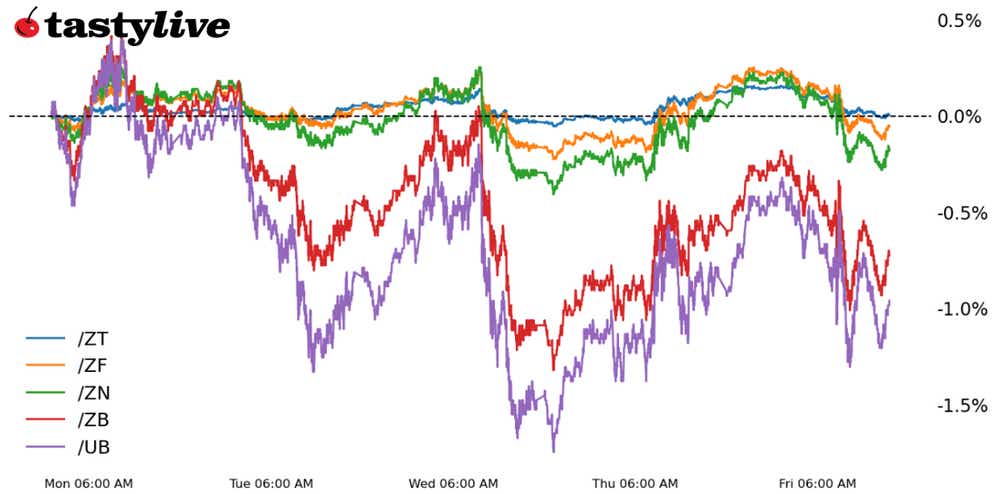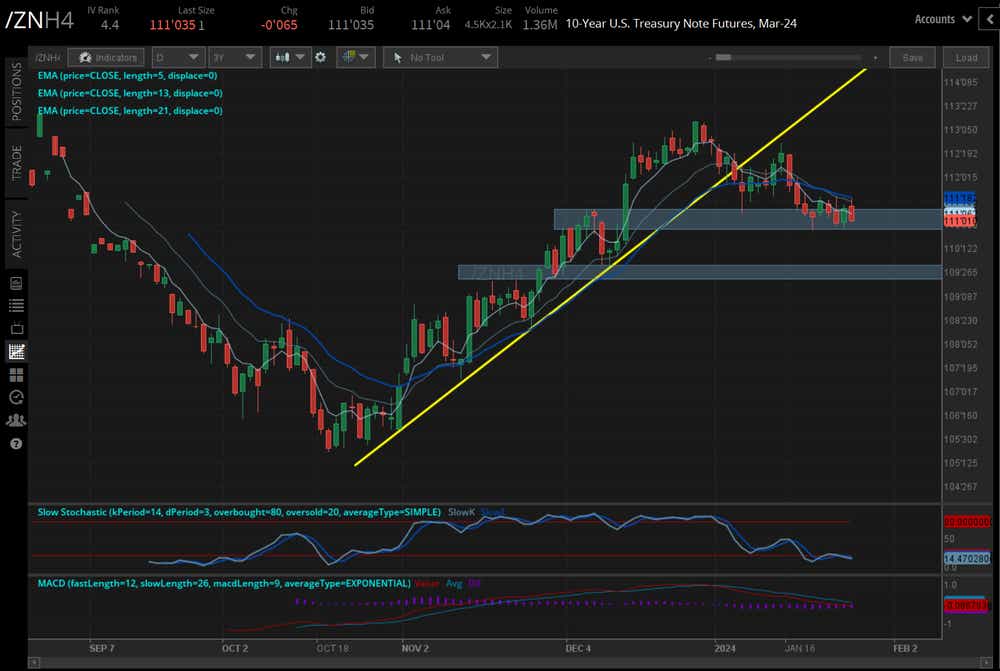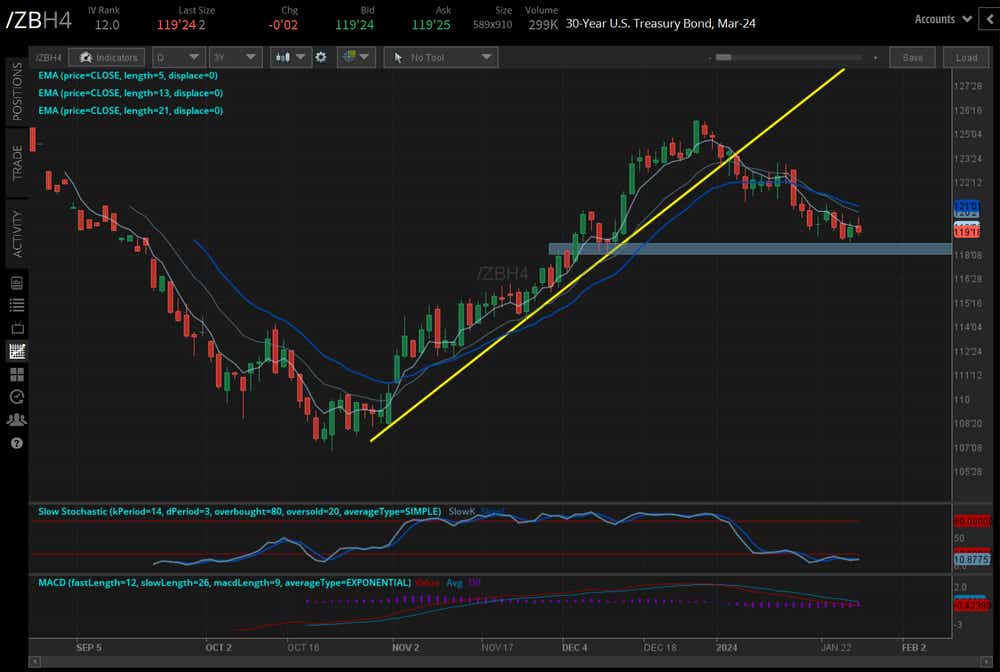Bonds Consolidating in Familiar Support Regions

Bonds Consolidating in Familiar Support Regions
The U.S. 10-year yield moves up to 4.147%
- U.S. Treasury notes and bonds are holding near their lowest levels of 2024.
- Rate cut odds for 2024 have plummeted, with the odds of a 25-bps rate cut in March down to 47.4% today from 81% at the start of last week.
- Bond volatility has all but completely disappeared.

Inflation is slowly but surely making progress towards the Federal Reserve’s medium-term target of 2% and the U.S. economy is growing at a strong clip.
Rate cut odds for the March Federal Open Market Committee (FOMC) meeting have likewise pulled back, from 81% at the start of last week to 47.4% today in the wake of the recent economic data. The net result for the bond market has been a pause in the sell-off, with neither bulls nor bears asserting much control over price action in recent days.
The forthcoming week may help wake bonds out of their slumber, which has become more pronounced in recent days as IVRs for 2s (/ZTH4), 5s (/ZFH4), and 10s (/ZNH4) have all dropped below 5, while 10s (/ZNH4) and 30s (/UBH4) have IVRs below 15. The disappearance of volatility is a marked shift from 2023, when volatility was consistently elevated.
Despite current market pricing, a week that promises the January FOMC meeting and the release of the January U.S. jobs report should help spark the next meaningful directional move in bonds.
/ZN U.S. 10-year note price technical analysis: daily chart (August 2023 to January 2024)

The U.S. 10-year Treasury note (/ZNH4) is working on its second-lowest close of the year on a daily basis and the lowest weekly close of 2024. But /ZNH4 is currently trapped in a familiar zone of support, the area where prices temporarily peaked in early-December 2023 and initially bottomed out on Jan. 5. Momentum remains weak, however, with /ZNH4 below its daily 5-, 13-, and 21-day exponential moving average (EMA) envelope (which is in bearish sequential order). Slow stochastics are trending lower in oversold territory, and moving average convergence/divergence (MACD) is still trending lower toward its signal.
A break of the current support zone around 111 would open the door for a deeper setback towards area around 109'20 that served as both support and resistance from mid-November to early-December.
As was the case last week, the lack of pickup in volatility (IV Index: 6.7%; IV Rank: 4.4) further underscores why bulls (particularly those that successfully sold puts at the end of 2023) need to be patient and let the charts unfold; there is little rhyme or reason to begin trying to collecting premium right now.
/ZB U.S. 30-year bond price technical analysis: daily chart (August 2023 to January 2024)

Like /ZNH4, U.S. Treasury 30-year bonds (/ZBH4) are working on their lowest weekly close of the year.
Momentum remains weak, with /ZBH4 exhibiting the same exact profile (EMAs, slow stochastics, and MACD) as /ZNH4. That said, /ZBH4 is already holding support at the area around 118’09/28, which proved pivotal at the end of November/beginning of December. We noted last week that this area “seems likely to prove to be an area of interest should downside price action develop further,” and it has held as support thus far. The renewed lack of volatility in /ZBH4 (IV Index: 12.3%; IV Rank: 12) suggests more patience is needed; a break of the downtrend from the intramonth swing highs would suggest long call spreads might become appropriate.
Christopher Vecchio, CFA, tastylive’s head of futures and forex, has been trading for nearly 20 years. He has consulted with multinational firms on FX hedging and lectured at Duke Law School on FX derivatives. Vecchio searches for high-convexity opportunities at the crossroads of macroeconomics and global politics. He hosts Futures Power Hour Monday-Friday and Let Me Explain on Tuesdays, and co-hosts Overtime, Monday-Thursday. @cvecchiofx
For live daily programming, market news and commentary, visit tastylive or the YouTube channels tastylive (for options traders), and tastyliveTrending for stocks, futures, forex & macro.
Trade with a better broker, open a tastytrade account today. tastylive, Inc. and tastytrade, Inc. are separate but affiliated companies.
Options involve risk and are not suitable for all investors. Please read Characteristics and Risks of Standardized Options before deciding to invest in options.
tastylive content is created, produced, and provided solely by tastylive, Inc. (“tastylive”) and is for informational and educational purposes only. It is not, nor is it intended to be, trading or investment advice or a recommendation that any security, futures contract, digital asset, other product, transaction, or investment strategy is suitable for any person. Trading securities, futures products, and digital assets involve risk and may result in a loss greater than the original amount invested. tastylive, through its content, financial programming or otherwise, does not provide investment or financial advice or make investment recommendations. Investment information provided may not be appropriate for all investors and is provided without respect to individual investor financial sophistication, financial situation, investing time horizon or risk tolerance. tastylive is not in the business of transacting securities trades, nor does it direct client commodity accounts or give commodity trading advice tailored to any particular client’s situation or investment objectives. Supporting documentation for any claims (including claims made on behalf of options programs), comparisons, statistics, or other technical data, if applicable, will be supplied upon request. tastylive is not a licensed financial adviser, registered investment adviser, or a registered broker-dealer. Options, futures, and futures options are not suitable for all investors. Prior to trading securities, options, futures, or futures options, please read the applicable risk disclosures, including, but not limited to, the Characteristics and Risks of Standardized Options Disclosure and the Futures and Exchange-Traded Options Risk Disclosure found on tastytrade.com/disclosures.
tastytrade, Inc. ("tastytrade”) is a registered broker-dealer and member of FINRA, NFA, and SIPC. tastytrade was previously known as tastyworks, Inc. (“tastyworks”). tastytrade offers self-directed brokerage accounts to its customers. tastytrade does not give financial or trading advice, nor does it make investment recommendations. You alone are responsible for making your investment and trading decisions and for evaluating the merits and risks associated with the use of tastytrade’s systems, services or products. tastytrade is a wholly-owned subsidiary of tastylive, Inc.
tastytrade has entered into a Marketing Agreement with tastylive (“Marketing Agent”) whereby tastytrade pays compensation to Marketing Agent to recommend tastytrade’s brokerage services. The existence of this Marketing Agreement should not be deemed as an endorsement or recommendation of Marketing Agent by tastytrade. tastytrade and Marketing Agent are separate entities with their own products and services. tastylive is the parent company of tastytrade.
tastyfx, LLC (“tastyfx”) is a Commodity Futures Trading Commission (“CFTC”) registered Retail Foreign Exchange Dealer (RFED) and Introducing Broker (IB) and Forex Dealer Member (FDM) of the National Futures Association (“NFA”) (NFA ID 0509630). Leveraged trading in foreign currency or off-exchange products on margin carries significant risk and may not be suitable for all investors. We advise you to carefully consider whether trading is appropriate for you based on your personal circumstances as you may lose more than you invest.
tastycrypto is provided solely by tasty Software Solutions, LLC. tasty Software Solutions, LLC is a separate but affiliate company of tastylive, Inc. Neither tastylive nor any of its affiliates are responsible for the products or services provided by tasty Software Solutions, LLC. Cryptocurrency trading is not suitable for all investors due to the number of risks involved. The value of any cryptocurrency, including digital assets pegged to fiat currency, commodities, or any other asset, may go to zero.
© copyright 2013 - 2025 tastylive, Inc. All Rights Reserved. Applicable portions of the Terms of Use on tastylive.com apply. Reproduction, adaptation, distribution, public display, exhibition for profit, or storage in any electronic storage media in whole or in part is prohibited under penalty of law, provided that you may download tastylive’s podcasts as necessary to view for personal use. tastylive was previously known as tastytrade, Inc. tastylive is a trademark/servicemark owned by tastylive, Inc.